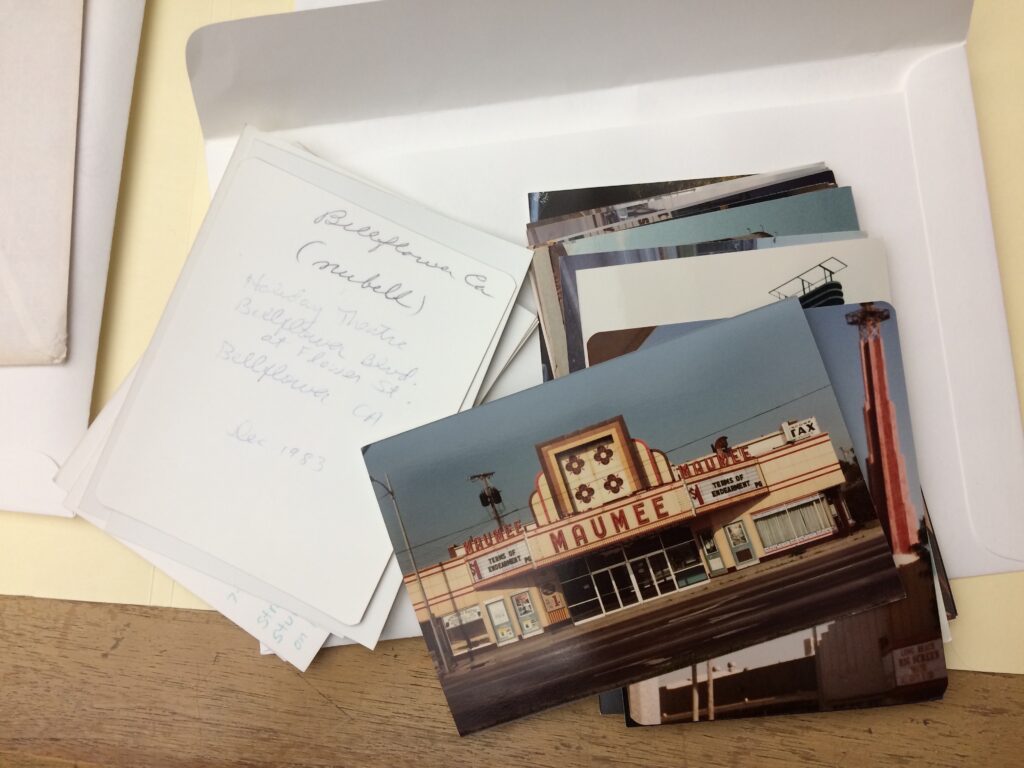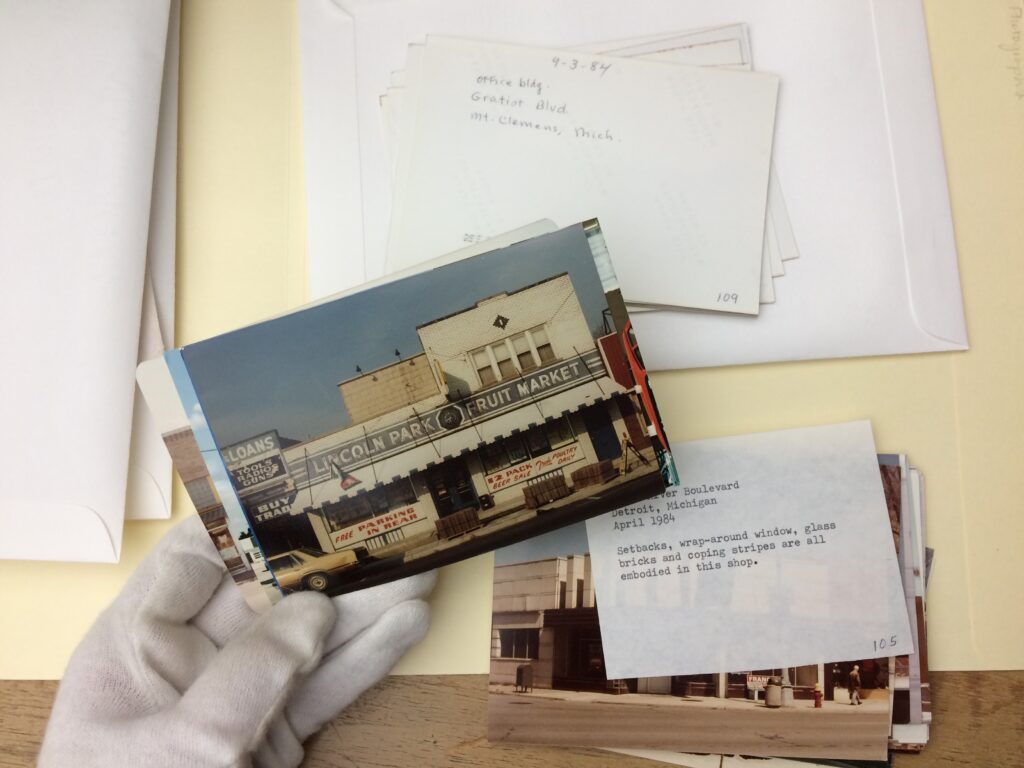
Introduction
This post is part of a series on personal collection management. The series provides tips and tricks to Society for Commercial Archeology (SCA) members for preserving and organizing their personal collections of photographs and print materials, and digitizing these items.
Personal collections management borrows best practices from collecting institutions like archives, libraries, and museums, scaled down for an individual’s needs. Following a few simple personal archiving guidelines can help preserve your memories into the future, keeping them accessible to the next generation.
In the Spring of 2019, I produced a Records Management plan for the SCA’s administrative records, which are housed at the Alexander Architectural Archives, University of Texas Libraries. These articles on personal collection management supplement the institutional Records Management tool, so that the personal materials of SCA members can be cared for at home, even outside of a formal archive.

Let’s Get Started!
A picture may be worth a thousand words, but only if it’s preserved. For many of us, our photographs, film, and slides contain our most cherished memories and familial ties. But, all too often these photographs sit neglected in damp basements, stuffy attics, and crumbling shoeboxes. The tips below will help your photos live their best life.
Handling
- Do not touch the image side of the print directly, to avoid leaving fingerprints and oils from the skin
- For best practice, wear thin cotton or nitrile gloves
Storing
Storage is the foundation of photo preservation. The right storage can be the difference between a photo that lasts a lifetime, and one damaged beyond repair.
- Store your photos in acid free boxes or envelopes
- For extra protection, photos can be layered between sheets of acid free paper, or slipped into clear archival envelopes
- Store negatives in acid free envelopes
- Avoid storing photos in spaces with wide fluctuations in temperature or humidity, such as attics, basements, or garages. As one blogger puts it: “A good rule of thumb is storing photos where you are also comfortable: not too hot, cold, wet or dry.”
- Store photos in a well-ventilated area
- Avoid storing photos or photo boxes in direct sunlight
- Avoid using paper clips or rubber bands to bundle photographs
- When storing photos in boxes, avoid “dead space” which will cause your photos to tip and lean. This can bend your prints, and mix them up out of order. Fill the dead space with folded pieces of stiff acid-free paper.
- Similarly, avoid packing prints or slides too tightly into a box. Give them a little breathing room so that the materials are not stressed or damaged by constantly pushing against one another.
Labeling and Organizing
Labeling your photos may feel tedious in the moment, but it can save you from pain and confusion down the line. Have you ever looked back on an old photograph that you took or one taken of you, and had no recollection of the moment? Or what about inheriting a box of old family photographs, without any idea of who the photos depict or when they were taken? Our memories aren’t perfect, but thankfully, labeling can step in for us.
- Types of information you may wish to include in the label:
- Full names of people in the photo
- Date
- Location
- Occasion
- Photographer
- Use gentle pressure to label the backs of photographs at the lower border. Avoid pens which require a forceful hand, as the pressure can damage your photo.
- If labeling each individual photo is too time-consuming, label boxes or envelopes which contain photos that are part of a set. (Best practice is to label the envelopes before placing the material in them).
- There is no single “correct” way to organize your photos. Chronologically, by person, by occasion? Choose a method that makes sense to you, and will make it easy to find the photo you’re looking for in the future.
Displaying and Sharing Photos
Storing photos for the future is great, but what if you want to enjoy your photos in the moment?
- If you want to frame a photo for display, consider making a copy, rather than displaying the original. This way you can enjoy your photo everyday, while the original is protected from light damage.
- Storing photos in an album is generally not recommended. Album materials like glue, cardboard, and plastic, can damage your photos. Instead, scan the photos and produce an album with the digital scans (through services like Shutterfly, Mixbook, or Amazon photos), or make photocopies for an album. The originals can then be left in protected storage.
- Look for acid-free frames, mats, and albums.

Further Resources
Looking for more? This section links to lots of helpful outside resources.
General Advice for Photographic Care
- Smithsonian Institution Archives, You Asked, We Answered: Taking Care of Your Own Archives
- National Museum of American History, You Asked, We Answer: Taking Care of Your Own Archives
- American Institute for Conservation, Photographic Materials Wiki
- Australian National MaritimeMuseum, How to Preserve Your Family Photographs [Video]
- State Archives of North Carolina, The Care and Preservation of Family Photographs [Video]
- The Spruce Crafts, How To Properly Store Old Photographs
- Gaylord, Understanding Archival Specifications and the Photographic Activity Test
Caring for Photographic Slides
While most of the advice on caring for photo prints also applies to slides, the following resources are specific to slides.
- Smithsonian Institution Archives, Storage of 35mm slides in carousels
- Archival Methods, American Family Archives | Preserving 35mm Slides
Purchasing Archival Supplies
Where to find acid-free boxes, photo sleeves and more.
Troubleshooting
Wondering how to take care of a collection of photos that’s already experienced damage? Below are resources for addressing common types of damage or degradation.
Mold
- Northeast Document Conservation Center, Emergency Salvage of Moldy Books and Paper
- Conservation Wiki, Mold Removal From Photographic Materials
- Hunker blog, How to Clean Mold Off of Photographs
- American Library Association, Saving Photos that Smell Moldy
Removing tape, removing photos from an album
- American Library Association, Preserving Photos in an Album
- American Institute for Conservation, Hinge, Tape, and Adhesive Removal
- Central Michigan University, Preserving Memories – Caring for Your Heritage: Scrapbooks, Photo Albums and other Memory Books
Hiring a Professional
Have a project too big to tackle alone? Try The American Institute for Conservation’s Find a Conservator feature.
Up Next!
Stay tuned for upcoming articles on digitization and tips on caring for paper materials like postcards, fliers, and clippings.
